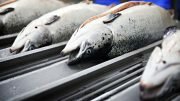Canned mackerel has been more popular than canned tuna in Japan. The Corona situation has increased the preference for mackerel. Mackerel is also the fish that most Japanese would like to eat more of.
Canned mackerel has for a while been surpassing tuna in the amount produced per ton in Japan. It started in 2013 when multiple tv programs described mackerel as good for one’s figure. That, combined with the media’s focus on mackerels’ high content of healthy fatty acids and positive effects for their health, has made canned mackerel shoot past canned tuna the following years. Mackerel sales have only increased together with general mackerel consumption since then.
It is the association “Canned Food Association of Japan” that keeps track over the production of canned foods. The newest statistics show a record-breaking year in 2018. The production of canned mackerel came close to 50,000 ton while the production of canned tuna came close to 32,000 ton. The numbers this year have so far not been made public, but data from grocery stores show that the gap between tuna and mackerel has increased significantly in relation to the corona situation. There are many reasons for this according to the Seafood Council’s fishery envoy to Japan, Gunvar L. Wie.
Just like in different countries, the corona crisis has led to hoarding and an increased focus on healthy and long lasting food. Canned mackerel became the bestseller because it is healthy and has a long shelf life. The mackerel can be eaten straight out of the can as it is or be mixed and matched with other foods.
Trendy mackerel
Health focus has also been one of the main reasons for mackerel, not just canned, to be very popular in Japan. Trendy restaurants where mackerel is on the menu has been popping up everywhere. Fast food mackerel stands in malls have become a healthy alternative to a hot-dog and mackerel has basically received a permanent spot in shelves among health food stores in the form of protein bars. While we back home eat a relatively small amount of mackerel, and mainly with bread, the mackerel consumption has gone up and over in Japan, reports Gunvar L Wie.
-” From 2017 to 2019 the consumption of all types of mackerel has increased by 32 percent. The most recent study on seafood from Japan shows that mackerel is also the fish that most people would like to eat more of, and is the third best most liked species of fish by the Japanese.”
Reports point towards good availability and good amount of variety between easily made and readily marinated mackerel products as an important factor for growth in the consumption of mackerel and its rise over tuna as.
-” Over the last few years there has been a number of new fast food products on the market that can be bought almost anywhere. The products are readily marinated or had added taste of sorts that can be heated in an oven in 1-2-3 and then eaten right out of the can, which in this case has a variety of mackerel in a can, and it tastes really good.”, he adds.
Processed mackerel products on the rise
Japan is one of the most important markets for Norwegian mackerel, both in quantity and value.. Just last year, Norway exported 49000 tons of mackerel with a value of 950 million Kroner directly to Japan. A significant amount of Norwegian mackerel also finds its way to Japan through processing plants in China and Southeast Asia. We mainly export mackerel whole or in filet, while at the same time increasing the amount of processed mackerel imported by the Japanese.
-” Our new market survey shows that the amount of imports of processed mackerel to Japan has increased from 17 to 40 percent between 2017 and 2019. This includes not only canned mackerel, but also a host of other products such as ramen with mackerel, protein bars, vacuum packed and flavored variants steadily increasing.”, says Wie.
2019 was also the year that Japan’s total import of processed mackerel products (out of all countries) was for the first time bigger than the amount of imported whole and filet mackerel. With 94,000 tons the amount of processed mackerel accounted for 60 percent, according to Japanese import statistics.
-” The increase also reflects the growing demand of fast food and easy made mackerel dishes. If we look at the health benefits, availability, usability and good taste, it is not surprising that canned mackerel has become a bestseller during the corona crisis.”, said Gunvar L. Wie.
So far 2020 has shown to be rather good for all types of mackerel in Japan. From January to May, the Norwegian mackerel export increased significantly in both value and volume by 44 percent in comparison to last year.
Most Japanese have a preference for Norwegian mackerel, which is also being used in the marketing of products in the grocery stores. Unfortunately in the fast food sector it is not always easy for the consumer to find out where the mackerel is from.
-” Therefore it is very important to emphasize the Norwegian origin even when the product is further processed.”, says Wie.
Source: seafood.no / Norway Today






Be the first to comment on "Canned mackerel is a bestseller in Japan"